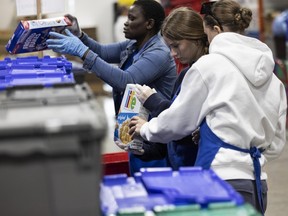Almost 25 per cent of food bank visits in B.C. were from working people, one of the highest rates in the country

Article content
Visits to B.C. food banks nearly doubled in the past five years, according to a new report from Food Banks Canada.
Food banks in the province recorded over 225,000 visits in March this year — about the population of Richmond. Seventy thousand of those visits included families with children under the age of 18.
“To get by in B.C. is just out of reach for an increasing number of people in the province,” said Dan Huang-Taylor, executive director of Food Banks B.C.
Advertisement 2
Article content
At the Surrey Food Bank, which served nearly 170,000 people last year, demand has increased by about 50 per cent since 2022, according to Kim Savage, the food bank’s executive director.
She said nearly half of the clients accessing services at the Surrey Food Bank have kids.
Both Savage and Huang-Taylor said the typical profile of a food bank client probably doesn’t match most people’s assumptions.
Almost 25 per cent of food bank visits in B.C. were from people working full time, one of the highest rates in the country.
Nearly 70 per cent are renters, compared with 10 per cent who are homeless and only six per cent who live in social housing.
Nearly one in five visits were from two-parent families.
Huang-Taylor said the working poor represent “an increasing proportion of the people who need to access services.”
That figure resonated with Savage, who said she has seen a significant increase in the number of working people and families coming to the food bank.
“They get to the end of their bank account before they get to the end of the month,” she said.
Low wages, the cost of groceries and housing are the main reasons people cite for needing to use food banks, according to the report.
Article content
Advertisement 3
Article content
The gap between B.C.’s minimum wage and its living wage — one that provided the necessities essential to an acceptable standard of living — was a significant driver of the increased demand for food banks, according to Huang-Taylor.
“We’ve got people who, for all intents and purposes, have done everything right,” he said. “They went to school, they got a degree, they got their qualifications, they landed a job, they’re working full time, and yet they still don’t have enough money to feed themselves or feed their families.”
“That is all you really need to know, in terms of how hard it is for so many people to get by,” he said.
The explosion in demand has left many food banks stretched thin.
While donations and funding to food banks has increased, they haven’t kept up with demand, forcing food banks to innovate and sometimes make tough choices.
The Greater Vancouver Food Bank recently implemented a policy refusing services to international students in an attempt to reduce demand for services.
“This is a system that’s buckling under the strain,” Huang-Taylor said.
For the most part, though, food banks have focused on maximizing resources, often by pooling resources and purchasing power.
Advertisement 4
Article content
Savage stressed the value of cash donations instead of canned or boxed goods, noting that many food banks can buy at a lower price than the public.
“I can buy a kilogram of apples for 75 cents that might cost $2.99 in the store,” she said.
Food banks across Canada reported a growing demand. Visits in Alberta jumped 90 per cent from 2019-2024, while the rate in Quebec and Ontario more than doubled.
The report called on governments to introduce measures including rental assistance and monthly payments to low-income people to help off-set rent and food costs.
Savage pointed out that Canada is a wealthy country that produces more food than it needs to feed its population.
“There is no reason that people in Canada should be facing food insecurity,” she said.
Recommended from Editorial
Bookmark our website and support our journalism: Don’t miss the news you need to know — add VancouverSun.com and TheProvince.com to your bookmarks and sign up for our newsletters here.
You can also support our journalism by becoming a digital subscriber: For just $14 a month, you can get unlimited access to The Vancouver Sun, The Province, National Post and 13 other Canadian news sites. Support us by subscribing today: The Vancouver Sun | The Province.
Article content




Comments